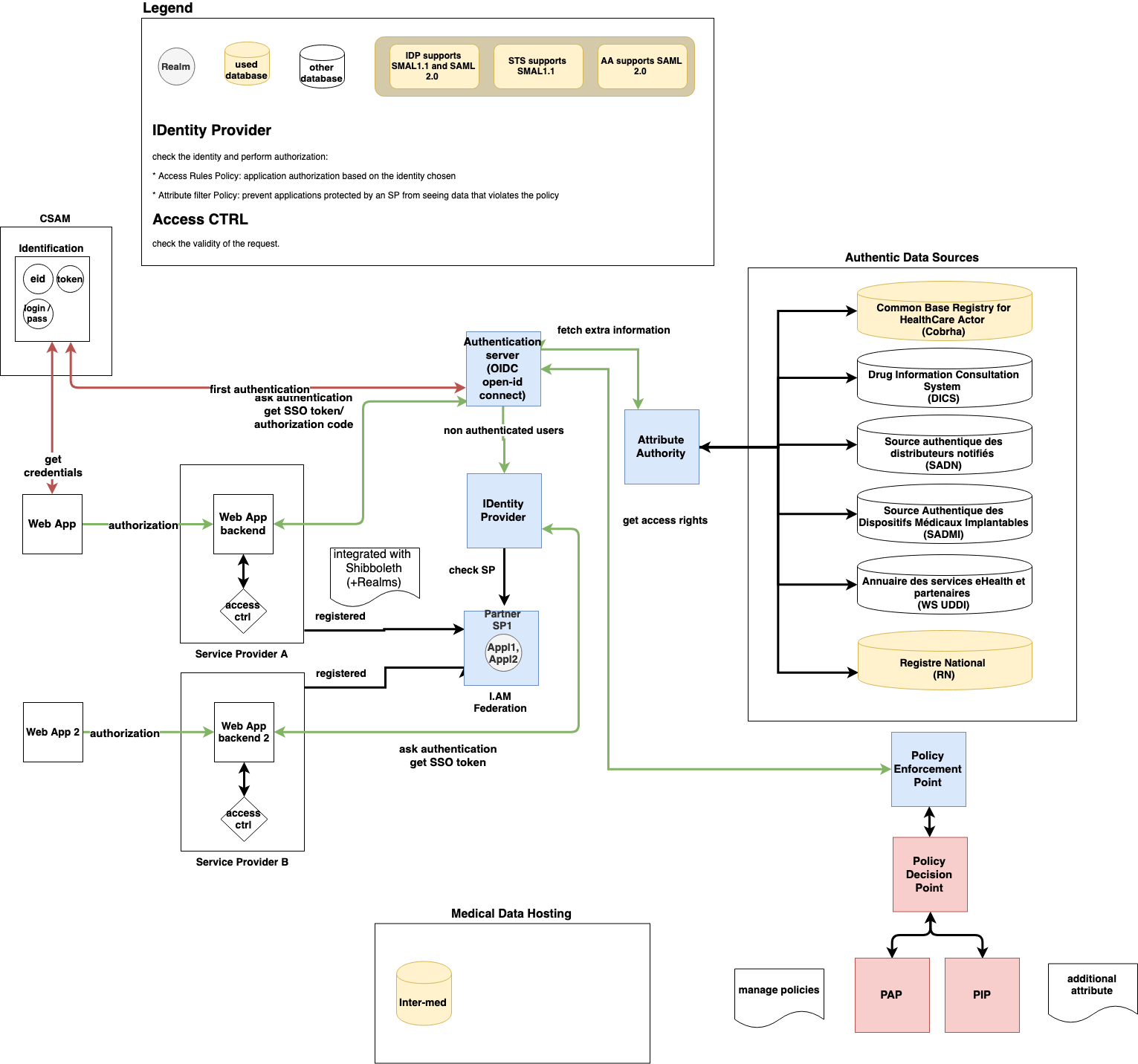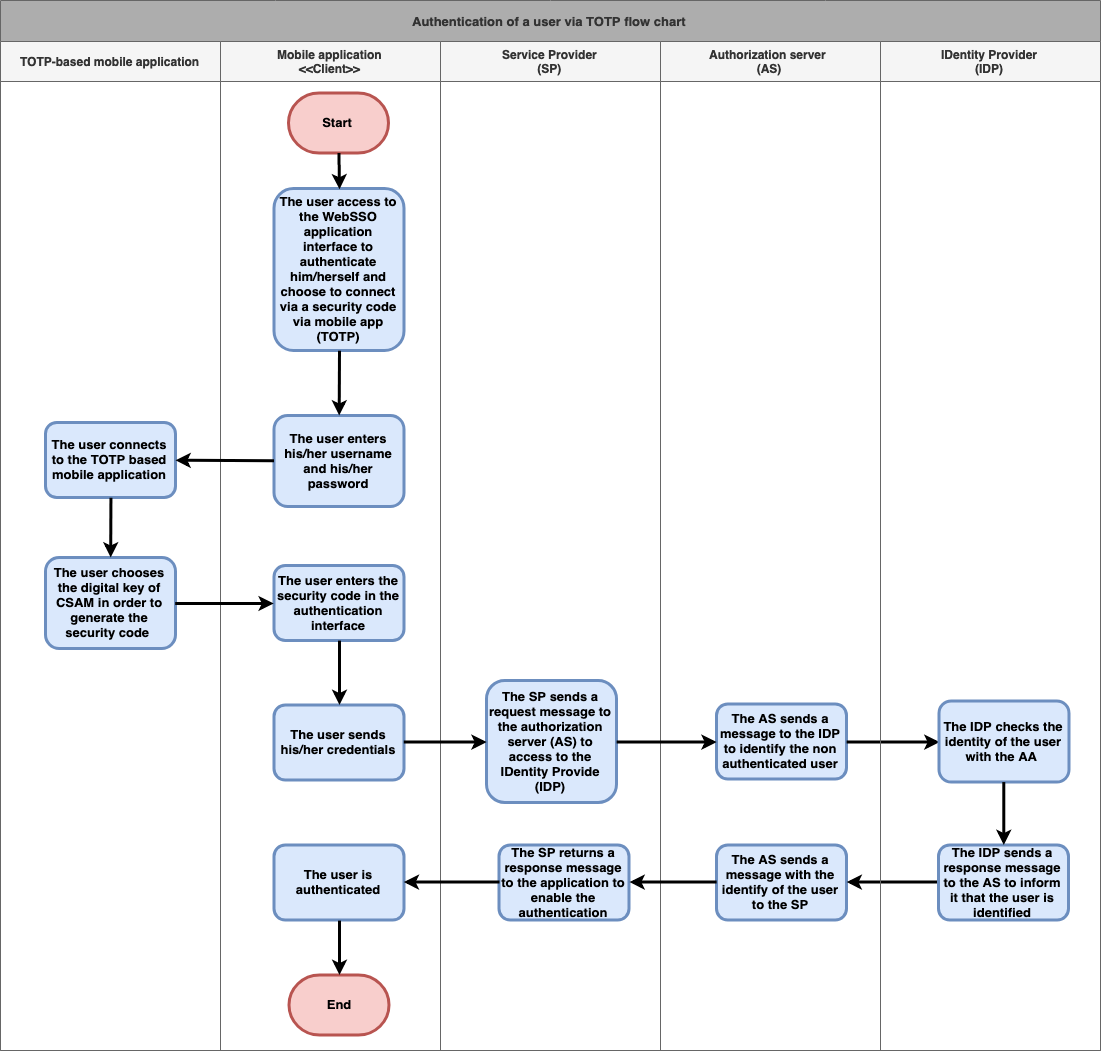Used documentation
| Cookbook/ materials | Version | Location |
|---|---|---|
| Identity & Authorization Management (I.AM) - Overview | 1.0 | https://www.ehealth.fgov.be/ehealthplatform/file/view/c87f7d093e56ff1054c73d6aae09e0bb?filename=ehealth_i.am_-_overv |
| Identity & Authorization Management (I.AM) - Identity Provider (IDP) | 1.0 | https://www.ehealth.fgov.be/ehealthplatform/fr/data/file/view/d43784683d86392e68f1a95b860f721170f30c7b?name=ehealth_i.am_-_idp_v1.0.pdf |
| CSAM Youtube channel | - | https://www.youtube.com/channel/UCzMGudd9xdMeGjYpbpjsXFw |
| Gestion de clés numériques sur CSAM | - | https://iamapps.belgium.be/sma/generalinfo?redirectUrl=%2Fsma |
| S'identifier sur un smartphone ou une tablette avec un code de sécurité via une application | - | |
| itsme video | - | |
| Gestion de clés numériques sur CSAM | - | https://iamapps.belgium.be/sma/generalinfo?redirectUrl=%2Fsma |
General information
In the figure below, we provide an overview about the interaction between the different services of the e-health platform involved in the IAM. It is noteworthy that the presented architecture is dedicated to the WebSSO solution.
Mobile application supporting the TOTP protocols
There are several mobile applications available that generate a unique time-based security code with which the user can authenticate him/herself. For instance, the following applications support the TOTP protocol:
- Google Authenticator (Android/iPhone/BlackBerry)
- Duo Mobile (Android/iPhone)
- Authenticator (Windows Phone)
Basic flow
| Flow | Specification | ||
|---|---|---|---|
Use case ID | ATH-UC-07-BF | ||
Use case name | Authentication via TOTP | ||
Actors |
| ||
Short Description | This use case denotes the authentication of a user via TOTP. | ||
1 (High) Must have: The system must implement this goal/ assumption to be accepted. | |||
Pre-Conditions |
| ||
Post-Conditions |
| ||
Steps (basic flow) | 0 | The user access to the WebSSO application interface to authenticate him/herself and choose to connect via a security code via mobile app (TOTP) | |
1 | The user enters his/her username and his/her password | ||
2 | The user connects to the TOTP based mobile application | ||
| 3 | The user chooses the digital key of CSAM and enters it in the authentication interface | ||
4 | The user sends his/her credentials | ||
5 | The SP sends a request message to the authorization server (AS) to access to the IDentity Provide (IDP) | ||
6 | The AS sends a message to the IDP to identify the non authenticated user | ||
| 7 | The IDP checks the identity of the user with the AA | ||
8 | The IDP sends a response message to the AS to inform it that the user is identified | ||
9 | The AS sends a message with the identify of the user to the SP | ||
| 10 | The SP returns a response message to the application to enable the authentication | ||
| 11 | The user is authenticated | ||
Exceptions (exception flows) |
| ||
Frequency |
| ||
Alternative flow 1
| Specification | ||
|---|---|---|
Use case ID | ATH-UC-07-AF-01 | |
Use case name | First authentication via TOTP | |
Actors |
| |
Short Description | Depending on the profile of the actor, this alternative flow will be instantiated by one of the four use cases dedicated to the creation of a new account (refer to the basic flows): ATH-UC-01, ATH-UC-02, ATH-UC-03, ATH-UC-04. To implement this flow, the user should authenticate him/herself in the mobile application using a TOTP-based mobile application. | |
Priority | 1 (High) Must have: The system must implement this goal/ assumption to be accepted. | |
Pre-Conditions |
| |
Post-Conditions |
| |
| Steps | For more details and depending on the type of the actor, see: | |
Exceptions (exception flows) |
| |
Frequency |
| |
Exception flow 1
| Specification | ||
|---|---|---|
Use case ID | ATH-UC-07-EF-01 | |
Use case name | The username or the password is not recognized | |
Actors |
| |
Short Description | It denotes the use case when the user tries to authenticate via a TOTP and fails in entering his credentials (username/password) | |
Priority | 1 (High) Must have: The system must implement this goal/ assumption to be accepted. | |
Pre-Conditions |
| |
Post-Conditions |
| |
Steps (basic flow) | 0 | The user access to the WebSSO application interface to authenticate him/herself and choose to connect via a security code via mobile app (TOTP) |
1 | The user enters his/her username and his/her password | |
2 | The authentication is interrupted because the credentials are not recognized | |
Frequency |
| |
Exception flow 2
| Specification | ||
|---|---|---|
Use case ID | ATH-UC-07-EF-02 | |
Use case name | The creation is aborted (e.g. loss of connection, the session is expired) | |
Actors |
| |
Short Description | It denotes the exception use case when the user loses the connection and he/she will not be able to finish the authentication. It may happens at any step of the basic and alternative flows. | |
Priority | 1 (High) Must have: The system must implement this goal/ assumption to be accepted. | |
Pre-Conditions |
| |
Post-Conditions |
| |
Steps (basic flow) | ||
Frequency |
| |

